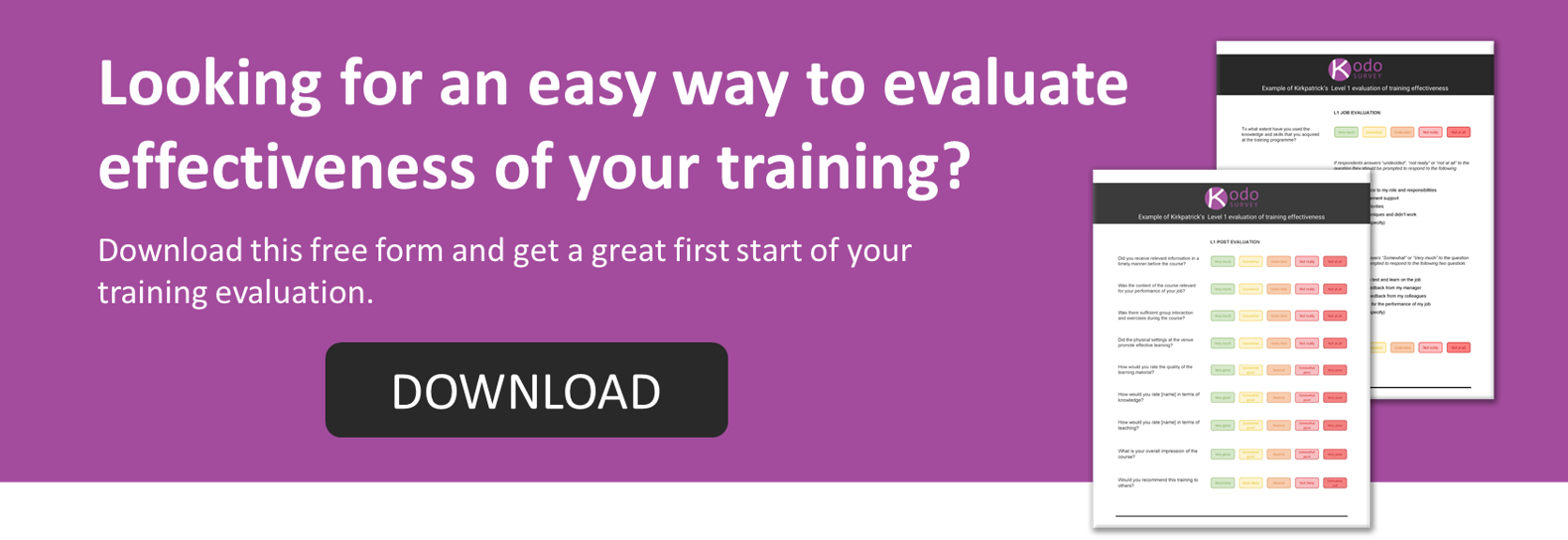
Need some help writing kick-ass training survey questions? We've got you covered. Our survey question examples will help you write amazing training survey questions in no time. We’ll help you determine the impact of your training and development and ensure that your training budget is being well spent.
Determining the learning impact
Before you start writing training survey questions, you need to get your learning impact map in place.
Step 1. Identify objectives and the desired results
Step 2. Outline the employee behaviors that will help you achieve these results.
Step 3. Outline the knowledge, attitudes, and intentions that will drive these behaviors.
Step 4. Define the measurable learning objectives of the training program.
With your learning impact map sorted, your next step is to define high-quality questions that generate valid results and help you meet your objectives.
The importance of asking objective questions
There are two types of training survey questions: objective questions and subjective questions. Objective questions have right and wrong answers and are based on facts or evidence.
Examples of such questions would include:
- How long did the training course last?
- Where was the training?
- What types of learning took place?
In theory, people’s answers to objective questions could be independently verified.
Subjective questions, on the other hand, are more about people’s reactions, feelings, and attitudes.
Examples of this type of question include:
- How did you feel about the training?
- What was your impression of the instructor?
- Did the training venue meet your expectations?
As answers are based on peoples’ opinions and thoughts, it is important that the questions are standardized so that people interpret them in the same way.
Understanding the differences between these two types of training survey questions is crucial to planning and writing good training survey questions and generating meaningful data. The get valid results, you need to ensure that the questions you write help you meet the objectives identified in your learning impact map.
For example, if you are following a training evaluation model like the Kirkpatrick model, you may use subjective questions in a Level 1 survey that aims to gauge participants reactions to the training they received. When you come to evaluate Level 2 (Learning) and Level 3 (Behavior) you will want to use objective questions that help you assess knowledge and understanding.

Types of responses to training survey questions
Although there are only two types of training survey questions, there are a number of different types of responses to these questions that you should know.
Here are the six most common types of training survey questions responses:
- Single-choice and multiple-choice questions
- Likert scale questions
- Rating questions
- Picture questions
- Closed-ended questions
- Open-ended questions
Almost all training survey question responses fit into one of those six categories. But there’s more to writing great questions than simply knowing this. If you want some of our best writing tips and examples, read on.

1. Single-choice and multiple-choice questions
Single-choice and multiple choice questions are great for training surveys as they offer respondents some flexibility in their answers and the results are straightforward to process.
For example:
What are the colors of the American flag?
- Green, yellow and blue
- Green, red and blue
- White, red and blue
- White, yellow and blue
This type of question would be commonly referred to as a multiple choice question as it gives the respondent more than one option to choose from. However, here at Kodo Survey, we define this type of question as a single-choice question as you are asking the respondent to select one response.
An example of a multiple choice question would be:
What are the colors of the American flag?
- Green
- Yellow
- Blue
- White
- Red
- Orange
In this example, the respondents can point out several options as correct and it is, therefore, a multiple-choice question.
2. Likert scale questions
Likert scale questions are a good choice for training surveys as they help you find out what participants think about certain things. If you are following the Kirkpatrick model, Likert scale questions are ideal for conducting a Level 1 evaluation where you gauge people’s reaction to the training. Likert scale questions usually come with 5, 7, or 9-point scales.
Some example Likert scale questions would be:
Please use this scale to answer the following questions.
Scale: 1 = Extremely dissatisfied, 2 = Dissatisfied, 3 = Neither satisfied nor dissatisfied, 4 = Satisfied, 5 = Extremely Satisfied
- The course content
- The venue
- The instructor
3. Rating questions
Rating questions are super-handy when it comes to gauging peoples’ opinions. They can use numbers such as 0-10, or graphics such as smiles, hearts or stars for respondents to select. Rating questions are a type of single-choice question where the respondents much choose one answer.
Some example rating training survey questions would be:
On a scale of 0-10, please answer the following questions;
- How clear was the course content?
- How helpful was the course instructor?
- How clean was the venue?
4. Picture questions
There are two main ways to use pictures in survey questions. Firstly, you can create picture choice survey questions. These are visual versions of single-choice and multiple choice survey questions that have pictures in the place of written answers. Pictures can make the survey more engaging and can help increase bounce rates.
For example, in our earlier single-choice question about the correct colors of the U.S. flag, you could include four different pictures featuring differently colored flags and the respondent would have to select one.
Kodo Survey platform doesn’t support the use of pictures for single-choice or multiple-choice question response options. However, it does support the use of pictures and movie clips in place of the question itself. This is helpful for measuring the respondents learning during Kirkpatrick Level 2 or 3.
An example of a picture-based question would be:
Look at the image. (The image shows a picture of a train cab. There are four buttons marked A, B, C, and D.) Which button should you press to stop the train?
The respondents would select a single answer from the options A, B, C, and D. This way of using a single-choice question in conjunction with an image helps measure knowledge. Short movie clips can also be used in place to the picture. Respondents can select one response (single-choice) or several (multiple-choice) based on what they see in the video.
5 Closed-ended questions
Closed-ended questions that require a single word answer such as ‘yes’ or ‘no’ are extremely helpful for training surveys. The answers provide useful insights and the results are simple to process.
Sample closed-ending training survey questions
- Did you enjoy the course (Yes/No)
- Would you recommend the training to others (Yes/No)
- Did you complete the course? (Yes/No)
6. Open-ended questions
Sometimes one-word answers aren’t enough – you need to use open-ended questions to get the required data. The downside is that the answers take longer to process. There’s nothing wrong with asking close-ended questions first and then leaving space for open-ended responses.
Sample open-ended training survey questions
- What was your impression of the instructor?
- In what ways do you think the training could be improved?
- How do you plan to use what you learned?
Get great data – by asking better questions
Surveys may be a time-tested way of gathering helpful data – but it’s all too easy to run a survey and fail to get the results you are looking for. That’s why we’ve put together a range of tips for writing better questions.
6 tip for writing great training survey questions
Designing an effective training survey is an art, but we’ve got six research-based tips that will help you get the information you need from the people who took the training.
Tip 1. Decide whether you need a survey or a questionnaire
Although many people use the terms ‘survey’ and ‘questionnaire’ interchangeably, there is a big difference. A survey is used for statistical analysis and helps collect data through a series of questions. A questionnaire is also used to collect data from questions but isn’t designed to be used for behavioral or trend analysis.
For example, when you potential employees come for an interview, you may ask them to complete a series of questions about their allergies. That’s a questionnaire.
However, if a medical company were to ask you to answer a few questions about your health, that’s would be a survey. The company will collate and merge your data with the answers given by other people. They will analyze the data and identify statistical trends.
Surveys and questionnaires are very similar and a large portion of a survey may be a questionnaire. You can even design a survey-questionnaire that starts as a questionnaire and then morphs into a survey.
To help you decide which one is right for you, check out Typeform’s guide on surveys vs questionnaires here.
Tip 2. Use extreme words to avoid a cap effect on Likert-scale attitude questions
When surveying respondents about their attitudes using Likert-scale questions, you’ll find that many people score themselves quite highly, giving you a cap effect. To avoid this, add extreme words such as ‘absolutely’, ‘highly’ and ‘extremely’ to push down the results and generate more useful data.
For example, consider this Likert 5-scale question about the importance of safety:
“It is important to conduct regular safety checks on all equipment.”
Most respondents would score themselves as high as four or five, thereby giving your results a cap-effect.
Now consider this rephrased question:
“It is extremely important to conduct regular safety checks on all equipment.”
This will push your results down and give you more valuable data.
Tip 3. Make alternative answers look equally right to the ‘untrained eye’
When you are writing single-choice and multiple-choice questions to assess knowledge for Kirkpatrick Level 2 and 3, be aware that some respondents are likely to guess if they don’t know the answer. Therefore you should always write the alternatives to look equally right compared with the correct answer. This avoids a situation where there is one obvious correct answer.
One approach is to ensure that the alternatives for the questions contain roughly the same number of words or symbols as the real answer. This will make it harder for respondents to guess the correct answer if they are unsure.
Lastly, you can include the option ‘Don’t know’ for both single-choice and multiple-choice questions. This will encourage the respondent to select this option instead of merely guessing the correct answer. Kodo Survey offers this option by default on all questions.
Tip 4. Make sure people can answer your questions
You’d think it would go without saying, but the biggest reason why training surveys fail is that they contain unclear or unanswerable questions. Avoid asking questions that are based on long term memory or complex calculations. Instead, ask for vague indications of things that people may readily know.
For example, most survey respondents wouldn’t be able to recall the exact chapters or modules covered by a recent training course that they attended. But they would be able to indicate the broad areas that it touched upon (customer service, sales, management, etc.).
Poor training survey question: How many customer complaints did your department receive last month?
Better question: In the past month, was the number of customer complaints handled by your department…. 1) the same as usual, 2) less than usual, 3) more than usual.
Tip 5. Avoid asking hypothetical, assumptive, biased, or loaded questions
Pay careful attention to the way that you phrase your training survey questions. Here are four types of questions to avoid at all costs:
Hypothetical questions
Most people struggle to predict how they’ll behave in the future in unfamiliar situations, so it’s best to avoid asking hypothetical questions to get the best training survey data.
Poor training survey question: If you took the next training module, would you use what you learned?
Better question: How likely are you to take the next training module?
Assumptive questions
Assumptive questions assume a certain fact and may be irrelevant to the survey taker.
Poor training survey question: Will you use the knowledge and skills that you gained from the training in your job.
This question assumes that the respondent acquired knowledge and skills from the training.
Better question: Did you develop your skill at …. in the training? If so, will you use this skill in your job?
This is a technique called ‘logic jump’ that lets people skip questions that don’t apply to them. In the above example, people who didn’t feel that they developed their skills during a training course wouldn’t have to answer the second part about using them at the workplace.
Biased questions
Biased questions may influence your training survey results by triggering emotional responses. For example, if you are following the Kirkpatrick training evaluation model and want to conduct a level 1 survey to evaluation trainees’ reactions, a biased question would be: Do you agree that the course instructor did a wonderful job of delivering the training?
This biased question would be more likely to garner favorable responses from the survey takers and can give you unreliable training survey data. It’s better to phrase questions is a simple, natural and emotionless way, such as: Please rate the instructor’s performance on a scale of 1 to 5.
Loaded questions
Loaded questions are similar to assumptive questions as they usually include a false premise. For instance: Do you think this training will help the company prosper given the country’s weak economic climate?
This question is pushing respondents to confirm a premise (that the country has a weak economic climate) that may not be true, nor may they agree with. This makes the question unanswerable and generates unhelpful survey data.
Tip 6. Avoid being vague or ambiguous
One of the toughest parts of writing good training survey questions is ensuring that everyone will understand what they mean. As the author, the meaning may be clear to you. But don’t take for granted that other people will know.
Ambiguous training survey question: Over the past 12 months, how many training opportunities have you had?
In this case, people’s understanding of ‘training opportunities’ will not be consistent. Some people may interpret it to mean dedicated training sessions, while others may include online training, workplace mentoring or part-time study.
A better training survey question would be: Over the past year, roughly how many workshops have you attended (0, 1-2, 3-5, more than 5).
This question will get people to respond more directly and will give you better training survey data to work with.
Closing Thoughts
Our tips should help you decide on the best training survey questions to ask and the best way to phrase them to get the results you need. Your focus should be on writing highly relevant, clear and concise questions that will generate useful data. We recommend testing your survey on volunteers before rolling it out, as this will help you identify flaws and ways of improving your questions.
To find out more, download our white paper, Determining and optimizing the impact of your training and development, or book a meeting with one of our experts.
